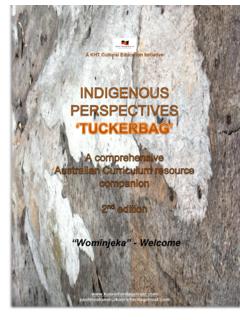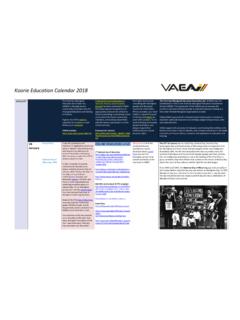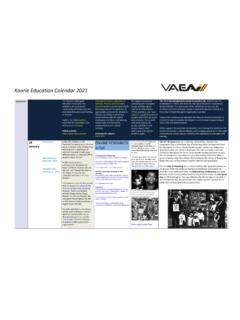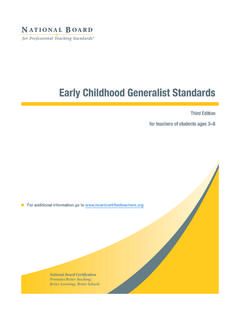Transcription of WALKING TOGETHER - VAEAI
1 WALKING TOGETHER An inclusion support and protocols resource for generalist early childhood education and care services developed in partnership between the Victorian Aboriginal Education Association ( VAEAI ) and the Victorian Inclusion Agency (VIA) Foreword It gives me great pleasure to support WALKING TOGETHER developed by the Victorian Aboriginal Education Association Inc. ( VAEAI ) and the Victorian Inclusion Agency (VIA), with assistance from Yappera Children s Service Cooperative. I am a Bangerang/Wiradjuri woman who has lived in the Goulburn Valley for most of my life. I was born the eleventh of fourteen children and my mother was widowed, so we all looked after each other.
2 My mother knew how important it was for us to get an education and she wanted her children to end up working in the Community, so she really encouraged us with our schooling. I ve now been working in the field of education for over forty years, and I m particularly passionate about early childhood education. I also have four children of my own, with my husband Nev, and we have nine grandchildren. It s really important for early childhood education and care staff to have an understanding of Aboriginal people, culture, lifestyles, and the impact of colonisation on the Community. This is not about feeling guilt, but feeling empathy and having an appreciation for the struggles that our people have endured and still do.
3 There should be opportunities for professional development in cultural understanding and safety, so that educators are able to create Koorie-inclusive learning environments where Aboriginal and Torres Strait Islander children and families are welcomed and acknowledged. And this needs to be an ongoing practice not something that happens just for NAIDOC or Reconciliation Week, but something that is embedded in daily routines, centre resources and the physical setting of services. Starting with displaying the Aboriginal and Torres Strait Islander flags and an acknowledgement plaque to recognise Traditional Owners is simple. Building a relationship with the local Community is integral to an ongoing, more in-depth practice.
4 Partnerships such as the one between VAEAI and the VIA are imperative to the health and wellbeing of our kids, and contribute to closing the gap in kindergarten participation. I encourage you to read WALKING TOGETHER a product of this partnership with the aim of creating positive outcomes for our Aboriginal and Torres Strait Islander children. VAEAI is excited about the prospect of as many generalist Victorian ECEC services as possible becoming places where Koorie children, their families and the community feel acknowledged, welcome and included. Geraldine Atkinson President, Victorian Aboriginal Education Association Incorporated ( VAEAI ) 2018 Victorian Aboriginal Honour Roll Inductee Inaugural Co-Chair of the First Peoples Assembly of Victoria 2 Acknowledgments This version of WALKING TOGETHER was revised and updated by Matilda Darvall, Senior Policy Officer in the Early Years Unit at VAEAI .
5 The original version was co- authored by Anita Singh, former Indigenous Professional Support Consultant from Yappera Children s Service Cooperative, and produced by Community Child Care Association. Co-authors Dr Anne Kennedy and Anne Stonehouse contributed significantly to the original version of this resource by bringing to bear their experience as early childhood educators, researchers and authors, and guiding educators to challenge and examine practice in education and care services. Marli Traill, Professional Support Consultant, Community Child Care Association, provided substantial assistance to the authors. We would also like to acknowledge the following contributors: Aunty Glenda Charles Aunty Bev Murray Kayleene James Laura Thompson Robert Bamblett Kevin Ellis for the artwork Yappera Children s Service Cooperative Board, staff and children Indigenous Professional Support Unit (IPSU) Victorian Inclusion Agency the peak funding body for development of this resource, led by the Community Child Care Association (CCC) and delivered in partnership with Yooralla and KU Children s Services.
6 The Commonwealth Department of Education and Training the Early Childhood and Childcare Unit that funds the Inclusion Support Program (ISP). 3 SECTION 1 INTRODUCTION TO WALKING TOGETHER Overview 07 Cultural Perspectives in generalist Services 09 Links to Belonging, Being & Becoming 10 Embedding Aboriginal and Torres Strait Islander Cultures and Messages in Practice 11 4 CONTENTS SECTION 2 VICTORIAN ABORIGINAL AND TORRES STRAIT ISLANDER PEOPLE, CULTURES, CUSTOMS AND PROTOCOLS Anniversaries and Significant Dates for Aboriginal and Torres Strait Islander People 14 Cooperatives 16 Creation Stories 17 Family 18 Flags 19 Questions Commonly Asked 20 Collective terms for Aboriginal People around Australia 21 Languages 22 Significant People in Aboriginal and Torres Strait Islander Cultures 23 Traditional Owners of the Land in Victoria 23 Welcome to Country and Acknowledgment of Country 23 Totems in Victoria 24 Sad News and Sorry Business 24 SECTION 3 SUGGESTIONS FOR PRACTICE Choosing Resources Related to Aboriginal and Torres Strait Islander Cultures 26 Learning Opportunities and Experiences 26
7 Inclusive practices 28 Welcoming Aboriginal and Torres Strait Islander Families 29 SECTION 4 RESOURCES Victorian Aboriginal Organisations and Agencies 31 Books 32 Television, Film, Radio and Podcasts 32 Education Websites 32 REFERENCES 33 APPENDIX 34 5 SECTION 1 INTRODUCTION TO WALKING TOGETHER 6 Every child should be able to see themselves, their identities and their cultures reflected in the curriculum, so they can fully participate in learning and build a positive self-esteem. As the First Peoples of this country and the world s oldest continuous living cultures, Aboriginal and Torres Strait Islander people occupy a unique place in Australia s past and present, which should be not only acknowledged, but valued.
8 The Victorian Department of Education and Training (DET) recognises that generalist services need to offer more welcoming environments to Koorie families, because of the crucial role that Koorie culture plays in learning and self-determination. It is also clear that experiences of inequalities in early childhood can underpin lifelong disparities in health, educational achievement and wellbeing (Marrung ). Importantly, all students regardless of cultural background have a right to learn a full history of Australia and deserve to be able to engage in learning about Aboriginal and Torres Strait Islander people and cultures. This knowledge and understanding enriches all students ability to participate positively in the ongoing development of Australia.
9 Not only will learning about Aboriginal and Torres Strait Islander people, history and cultures and appreciating the place of Aboriginal and Torres Strait Islander people in Australia assist in achieving respect, recognition and reconciliation; it is also essential to understanding and implementing the Victorian Early Years Learning and Development Framework (VEYLDF). Acknowledgement of Aboriginal culture is highlighted in the VEYLDF as the first of four important areas of practice, and it is clearly stated that learning about and valuing the place of Aboriginal people will enhance all Victorian children s sense of place in our community. Similarly, the guiding principles that underpin the National Quality Standard in early childhood education and care (ACECQA) include the mandate to value Australia s Aboriginal and Torres Strait Islander cultures, and Early Childhood Australia s Code of Ethics acknowledges Aboriginal and Torres Strait Islander ways of being and caring for children, as informed by the principles in the United Nations Declaration on the Rights of Indigenous Peoples.
10 It is important for early childhood educators to understand that both content and methods of teaching are culturally subjective and value-laden. For this reason, there is a need to regularly examine whose perspectives are being prioritised in the classroom and whose are being minimised or even left out altogether. Every child has a right to participate fully in educational settings that respect their culture and language; settings where every child s identity and belonging to family and culture are supported. All children benefit and learn from experiences that promote respect for many kinds of diversity. WALKING TOGETHER is a Victorian resource that provides a starting point for achieving three aims that focus on culturally appropriate and inclusive practice related to Aboriginal and Torres Strait Islander* people and cultures: 1.













